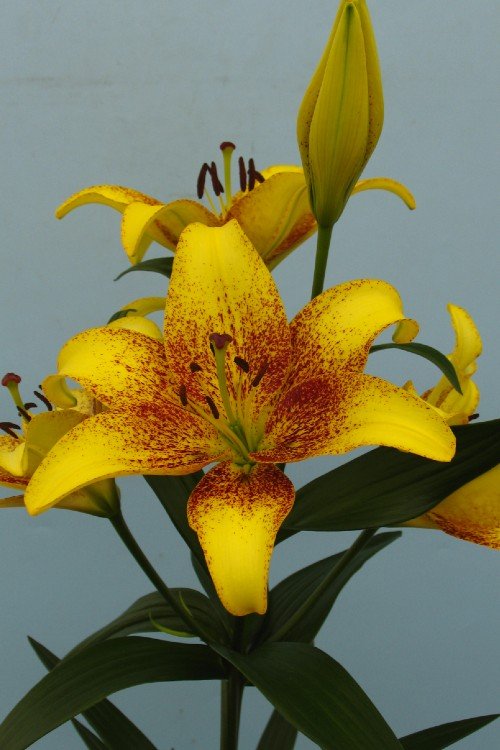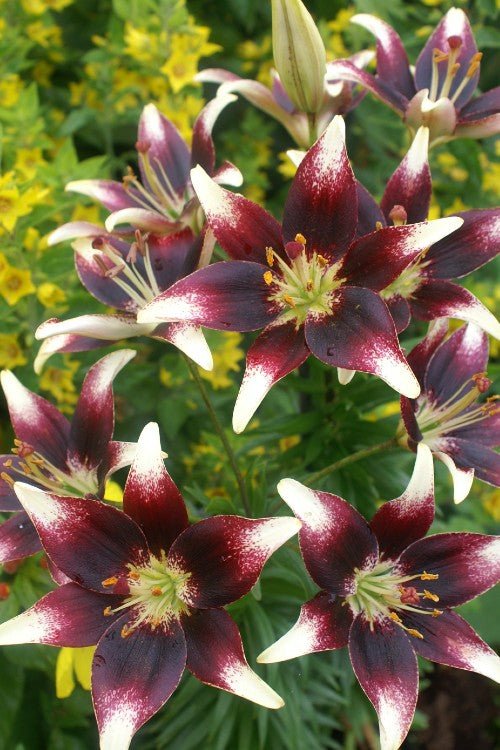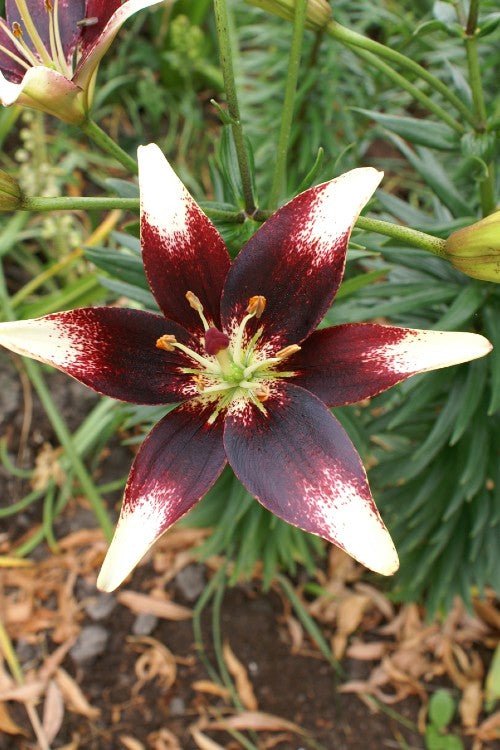Explore the Lily collection
Sort by:
About After Eight
Lily After Eight is the perfect addition to any garden or flower bed. This stunning bulb produces tall, elegant stems with large, fragrant flowers that bloom in late summer. The unique, deep pink color with white edges of the After Eight Lily will surely add elegance to any space.
- Produces tall, elegant stems with large, fragrant flowers
- Grows to a height of 18 inches
- Strong, sturdy stems
- Unique, deep pink color adds a touch of elegance to any space
- Blooms in late summer
- Perfect for gardens or flower beds
How to care for After Eight
- Lily After Eight should be planted in the spring in an area with good drainage and rich, loamy soil
- Plant the bulbs approximately 6 inches deep and 8 inches apart
- Cover the bulbs with soil and lightly water the area
- Water regularly and thoroughly during the growing season
- Fertilize in early spring with a high-nitrogen fertilizer
- Stake the stems if needed, as the blooms can become very heavy
- Deadhead faded flowers and remove any dead foliage. Lift and divide the bulbs in the fall, replanting the bulbs 3-4 feet apart
- Add a layer of mulch to the area to help retain moisture during the winter months
About Aisha
Lily Aisha boasts delicate petals, adding a touch of elegance to any landscape. Aisha grows to a height of 24 to 32 inches, and is a Roselily Lily. This category is double-flowered, very unique and has a very mild fragrance. Aisha is a beautiful white Lily. What else to love about Lily Aisha?
- Fragrance delight: enjoy a garden filled with a sweet, lingering fragrance as the Lily Aisha unfolds its petals.
- Adaptable to various climates: thrives in diverse climates, making it a versatile choice for gardens across regions.
- Low maintenance: a resilient beauty that requires minimal care, perfect for both novice and experienced gardeners.
- Long blooming period: revel in an extended blooming season, ensuring continuous beauty throughout the growing months.
How to plant and take care of Lily Aisha
- Plant bulbs in well-drained soil to prevent waterlogging.
- Choose a sunny location for optimal growth.
- Water consistently but avoid overwatering to prevent bulb rot.
- Apply a balanced fertilizer during the growing season.
- Deadhead spent blooms to encourage continuous flowering.
About Anastasia
The Lily bulb Anastasia brings an unmistakable flair of elegance to your garden. With its tall and slender stems, the blooms of its fragrant flowers will illuminate your garden in the summer months.
- Large, luscious blooms in shades of pink, and white
- Sturdy stems and foliage
- Blooms continuously until the first frost
- Highly scented
- Can reach up to 7-9 ft. tall
- Each stem produces up to 25 flowers
- Anastasia is a crossing of oriental and trumpet Lilium
How to care for Anastasia?
- Before planting, choose a sunny spot with well-draining, moist soil.
- Dig a hole large enough to accommodate the rhizome, and sprinkle some slow-release fertilizer into the bottom.
- Place the rhizome in the hole with the pointed part facing upwards.
- Cover it with soil and press it down.
- Water your lily well and it should be ready to go.
- Be sure to water them regularly and keep the soil moist, but not soggy.
- Deadhead spent flowers to encourage more blooms.
About Anouska
Lily Anouska is a gorgeous Roselily Lily. Roselily Lilies are known for their double petals, which makes Anouska unique and a showstopper in your garden. The edges are pink, fading into white in the middle. They have a subtle, sweet scent, but not so strong as the Oriental Lilies. Anouska is an elegant looking Lily, because of its color and beautiful double petals.
- Classy colors: Lily Anouska showcases a stunning palette, blending soft pinks with pristine whites.
- Fragrance: enjoy a garden filled with a subtle, sweet fragrance that captivates the senses.
- Adaptable: thrives in various soil types, making it an ideal choice for diverse garden environments.
- Long bloom time: enjoy the extended flowering period, ensuring a vibrant display throughout the season.
- Low maintenance: eequires minimal care, making it perfect for both novice and experienced gardeners.
How to plant and take care of Lily Anouska
- Plant bulbs in well-drained soil during the spring, ensuring they receive ample sunlight.
- Water consistently, keeping the soil moist but not waterlogged.
- Apply a balanced fertilizer during the growing season to promote healthy blooms.
- Deadhead spent flowers to encourage continuous blooming.
- Provide support for taller varieties to prevent bending under the weight of blooms.
About Baferrari
Elevate your garden with the enchanting Lily Baferrari, a botanical marvel that effortlessly combines elegance and vibrancy. Standing tall with regal petals in rich white, this lily variety captivates with its striking beauty.
- Vibrant petals: stunning, white petals create a visual spectacle.
- Hardy structure: robust and resilient, suitable for various climates.
- Fragrance infusion: releases a delightful fragrance, enhancing your garden's ambiance.
- Versatile landscaping: perfect for borders, containers, or as cut flowers.
How to plant and care for Lily Baferrari
- Planting depth: place bulbs 4-6 inches deep in well-drained soil.
- Sun exposure: choose a sunny location for optimal growth.
- Watering: maintain consistent moisture, avoiding waterlogged conditions.
- Fertilization: feed with a balanced fertilizer during the growing season.
- Winter care: mulch around bulbs to protect from harsh winter conditions.
About Brasilia
The Lily bulb Brasilia is a stunning, long-lasting addition to any garden. With its vibrant white and mauve pink blooms, with green center, it is sure to make a statement in any space.
- Easy to plant and maintain
- Blooms in late summer
- Produce a wonderful fragrance
- Can be planted in a variety of soils
- Grows to a height of 3-4 feet
- Long-lasting cut flower
- Ideal for borders and patio pots
How to care for Brasilia
- Plant Brasilia in well-drained soil in the spring or fall, in a spot that receives full sun.
- Dig a hole that is twice as wide as the pot your lily is in and just as deep.
- Place the lily in the hole, spreading out the roots, and fill the hole with soil.
- Firm the soil around the lily and water thoroughly to settle the soil and roots.
- Water your Lily Brasilia deeply and regularly to keep the soil moist.
- Prune your Lily Brasilia if it starts to look scraggly, in late fall after blooming.
- Cut off the dead and damaged stems, then remove any stems that are not healthy.
- Mulch your Lily Brasilia in the spring to help keep moisture in the soil.
About Casa Blanca
The Lily bulb Casa Blanca is a classic, elegant choice for any garden. With its pure white blooms and green center, it adds a touch of sophistication to any space. The large flowers have stunning brownish-orange anthers, providing an interesting contrast to the petals.
- Easy to plant and maintain
- Blooms in mid to late summer
- Can be planted in a variety of soils
- Grows to a height of 3-4 feet
- Long-lasting cut flower
- Fragrant
- Tall, strong stems
- Perfect for the back of a border
How to care for Casa Blanca
- Plant Casa Blanca Lilies in full sun or light shade during the spring and early summer in soil that is moist but well-draining.
- Make sure to dig a hole twice as deep as the lily’s bulb and twice as wide.
- Place the bulb at the bottom of the hole and fill it with soil.
- Water the soil thoroughly after planting and make sure to water regularly until the plant is established.
- Deadhead the plants to promote more blooms and remove any wilted leaves or flowers.
- For winter protection, cover the foliage with mulch or compost.
About Fata Morgana
Discover the Lily Fata Morgana, a remarkable flower with stunning colors and long-lasting blooms:
- Beautiful, vibrant blooms in shades of yellow
- Flowering multiple times a season
- Long-lasting blooms
- Easily grown in the garden or in a pot
- The Lily Fata Morgana is the perfect choice for any garden or indoor space.
How to care for Fata Morgana
- Plant bulbs in well-drained soil in a sunny location
- Water regularly, but do not over-water
- Deadhead spent blooms to encourage new growth
- Apply a balanced fertilizer every two to four weeks during the growing season
- Allow the foliage to die back naturally before cutting back
About Friso
Introduce a touch of elegance and beauty to your garden with our Lily Friso. These stunning flowers are the perfect addition to any garden, with their vibrant colors and sweet fragrance.
- Vibrant colors: lilies Friso come in a variety of colors, including pink, purple, and white.
- Sweet fragrance: these lilies are known for their sweet fragrance, making them perfect for planting near patios or walkways.
- Long blooming period: these lilies will bloom for several weeks, providing a long-lasting display of beauty in your garden.
- Can reach up to 7-9 ft tall
- Produces approximately 25 flowers per tall stem
How to care for Friso
- When planting Friso, it is important to make sure they are planted in well-drained soil.
- Also, chose a location that gets full sun to partial shade (at least 6-8 hours of sunlight)
- Water 1-2 times a week and fertilize every 2-4 weeks
- Stake Friso when it’s blooming
- Deadhead spent blooms
About Golden Stone
The Lily Golden Stone is a stunning addition to any garden or landscape. This beautiful flower boasts vibrant golden petals that are sure to catch the eye. Not only is it a beautiful plant, but it is also easy to care for and maintain.
- Vibrant golden petals with orange-speckled center
- Easy to care for
- Perfect for any garden or landscape
- Great for growing in pots
How to care for Golden Stone?
- Choose a location that receives full sun to partial shade.
- The planting spot must have well-draining soil.
- Be sure to keep the soil consistently moist, but not waterlogged, to ensure proper growth.
- To care for the Lily Golden Stone, be sure to fertilize the plant regularly.
- Deadhead the flowers as they fade. This will encourage more blooms to appear.
- Also, be sure to watch for pests and diseases, and address them promptly if they appear.
About Henryi
The Lily Henryi is a stunning, vibrant flower that will add a touch of elegance to any garden. With its medium-sized, trumpet-shaped blooms and unique coloration, it's sure to be a showstopper in any outdoor space.
- Large, trumpet-shaped blooms in shades of orange and red speckles
- Grows up to 3 feet tall
- Blooms in late summer to early fall
- Unusual and rare Lily
- Has an amazing fragrance
How to care for Henryi
- Simply plant the bulbs in well-drained soil in a sunny location, where they get at least 6-8 hours of sunlight.
- They prefer to be planted in the fall, but can also be planted in the spring.
- Be sure to water the bulbs well after planting and keep the soil consistently moist until the plant emerges.
- Fertilize every two to four weeks during the growing season
- Deadhead spent blooms
About Isabella
The Lily Isabella graces your garden with elegance and vibrant allure. It is a Roselily variety which is known for its double petals. Isabella has a hot pink color, with a white edge. These features make it a must-have for any floral enthusiast. Embrace the Lily Isabella and effortlessly cultivate a garden filled with the charm of this botanical wonder.
- Majestic blooms: large, fragrant flowers with a height of 24-36''.
- Hardy: adaptable to various climates, ensuring year-round enjoyment.
- Low maintenance: thrives with minimal care, perfect for both novice and seasoned gardeners.
- Perennial brilliance: returns each year, providing enduring beauty to your outdoor space.
How to plant and take care of Lily Isabella
- Planting depth: place bulbs 6-8 inches deep in well-draining soil.
- Sun exposure: prefers full sun to partial shade for optimal growth.
- Watering: keep soil consistently moist but not waterlogged.
- Fertilization: apply a balanced fertilizer in spring for enhanced blooming.
- Winter care: mulch around the bulbs in late fall to protect from frost.
About Josephine
The Oriental Lily Josephine is the perfect addition to your garden. This Lily is a sweet-scented deep pink Lily with a white stripe reaching out from the center of the flower.
- Exotic and unique, the Lily Josephine is sure to impress with its large, vibrant pink blooms and white stripes
- Grows to a height of 3-4 feet, making it a great choice for borders and cut flowers
- Long-lasting blooms that will add a pop of color to your garden for weeks
- Hardy and resilient, the Lily Josephine can thrive in a variety of soils and climates
- Large flowers blossom during summer atop tall stems.
- Hardy and can be grown like a perennial
How to care for Josephine
- Plant in well-draining soil in a sunny spot in your garden
- Water regularly, making sure the soil is moist but not waterlogged
- Deadhead spent blooms to encourage new growth and prolong the blooming period
- Fertilize with a balanced fertilizer every 2-4 weeks during the growing season
About Lady Alice
The Lily Lady Alice is a beautiful and unique flower that will add a touch of elegance to any garden. This lily is known for its medium-sized, white flowers with an orange broad striped- center. It is a hardy plant that is easy to care for, making it a great choice for beginners and experienced gardeners alike.
- Medium-sized, white flowers with orange and orange speckles
- Easy to care for
- Hardy and long-lasting
- Great for beginners and experienced gardeners
- Produces a wonderful fragrance
How to care for Lady Alice
- To plant the Lily Lady Alice, simply dig a hole in well-drained soil.
- Place the bulb in the hole with the pointy end facing up.
- Cover with soil and water well.
- The lily will begin to grow in the spring and will bloom in the summer.
- Make sure to keep the soil consistently moist and fertilize regularly.
- Deadhead the flowers as they fade to encourage more blooms.
About Lancifolium Splendens
Have you heard of Lily Lancifolium Splendens? It is a stunning addition to your garden! This beautiful lily is also known as the Tiger Lily and is a must-have for any garden enthusiast.
- Its striking orange flowers with speckles are sure to catch the eye
- Easy to grow and care for
- A great choice for both experienced and novice gardeners
- Highly fragrant, perfect for attracting butterflies and bees
- Grows on firm stems rising to a height of 48-50"
- Flowers July - September
How to care for Lancifolium Splendens
- Plant in full sun to partial shade and well-drained soil for best results.
- Dig a hole, plant the lily bulbs with the pointy end upwards, and cover them with soil.
- Water regularly and fertilize once a month to ensure the health and longevity of your lily.
- Deadhead spent blooms.
- These lilies are also great for cutting, so you can enjoy their beauty both in the garden and in your home.
About Miss Feya
The Lily Miss Feya is a stunning, delicate flower that adds a touch of elegance to any garden. With its hot pink petals, maroon speckles, and sweet fragrance, it's sure to be a favorite among gardeners and flower enthusiasts alike.
- Gorgeous dark pink petals with a sweet fragrance
- Blooms in late spring to early summer
- Great for cut flowers
- Easy to care for
- Attracts butterflies and hummingbirds
How to care for Miss Feya
- Plant the Lily Miss Feya bulbs in well-drained soil in a sunny spot in your garden. They prefer a spot that gets at least 6 hours of direct sunlight per day.
- Plant the bulbs about 4-6 inches deep and 6-8 inches apart.
- Water the bulbs regularly to keep the soil moist, but not waterlogged.
- Fertilize the bulbs once a month with a balanced, slow-release fertilizer.
- Deadhead the flowers as they fade to encourage more blooms.
About Netty’s Pride
Lily Netty's Pride is a stunning LLily variety that is sure to add a touch of elegance to any garden. This beautiful flower is known for its large, trumpet-shaped blooms that come in a variety of colors, including maroon, cream, and green center.
- Easy to grow and maintain: Lily Netty's Pride is a hardy plant that is easy to care for, making it a great option for both experienced and novice gardeners.
- Long-lasting blooms: these lilies will bloom for several weeks, providing a long-lasting display of color in your garden.
- Versatile: Lily Netty's Pride can be planted in a variety of settings, including borders, beds, and pots.
- Low maintenance: once established, these lilies require very little maintenance, making them a great option for busy gardeners.
- Grows to a height of 40 inches with flowers of 5" in diameter
How to care for Netty’s Pride
- Pick a sunny spot with well-drained soil
- Simply dig a hole that is slightly larger than the bulb and plant it at a depth of about 6 inches.
- Water well and keep the soil consistently moist until the plant is established.
- Fertilize every 2-4 weeks during the growing season.
- Once established, Lily Netty's Pride requires very little maintenance, making it a great option for busy gardeners.
About Pieton
The Lily Pieton is a stunning flower that will add a touch of elegance to any garden. With its delicate petals and vibrant colors, it is sure to be the focal point of any space.
- Has deep yellow outer petals and dark burgundy with speckles toward the center
- Lightly fragrant
- Produces upright flowers
- Very hardy
- Easy to care for
- Perfect for both experienced gardeners and beginners
How to care for Pieton
- This Lily prefers full sun and well-drained soil and should be planted in the spring or fall.
- To ensure healthy growth, be sure to water the plant regularly.
- Fertilize it every 2-4 weeks during the growing season.
- With proper care, the Lily Pieton will return year after year, providing beauty and joy to your garden for many years to come.
FAQs
























